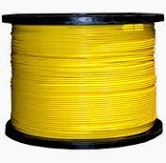How Flexible and Tough Are Fiber Optic Cables?
A Simple Guide to Bend Radius and Durability
Fiber optic cables are the backbone of modern communication systems. They are used in homes, businesses, data centers, and across large networks to transmit data at the speed of light. But while most people talk about their speed and efficiency, not everyone pays attention to two very important features: bend radius and durability.
In this blog post, we’ll explain what these terms mean, why they matter, and how you can choose the right fiber optic cable for your needs especially if you’re working on a network installation or upgrade.
Whether you’re a beginner or a tech professional, this guide will help you understand fiber optic cable strength and flexibility in simple words.
What is Bend Radius?
Bend radius refers to how much you can safely bend a fiber optic cable without damaging it. Think of it like this: if you try to bend a straw too tightly, it will pinch, break, or stop working properly. The same thing can happen to a fiber optic cable.
When a fiber cable is bent beyond its recommended bend radius, the light that travels through the fiber can escape or reflect incorrectly, which leads to signal loss or even permanent damage.
Types of Bend Radius
There are two types of bend radius to know about:
- Dynamic Bend Radius: This is the minimum bend radius while the cable is being installed or moved.
- Static Bend Radius: This is the minimum bend radius when the cable is not being moved or is already installed.
Each cable type will have specific numbers based on the manufacturer’s guidelines, but a general rule is:
Minimum Bend Radius = 10x the cable’s outer diameter (for static bends)
Minimum Bend Radius = 15x the cable’s outer diameter (for dynamic bends)
Why Bend Radius Matters
If you don’t follow the recommended bend radius, you risk:
- Signal loss
- Cracked or broken fiber
- High maintenance costs
- Reduced network performance
Especially in tight spaces like data centers or when routing through walls, bend radius must be carefully managed.
What is Durability in Fiber Optic Cables?
Durability refers to how strong and long-lasting a fiber optic cable is under stress. This includes:
- Physical stress (pulling, crushing, or twisting)
- Environmental stress (exposure to moisture, heat, cold, chemicals)
- Installation stress (bending, stretching, or pressing during setup)
Fiber optic cables are made of glass, but they’re protected by layers of strength materials like Kevlar, gel, plastic coatings, and armored jackets to increase durability.
Factors Affecting Durability
- Outer Jacket Material: Materials like PVC, LSZH (Low Smoke Zero Halogen), or Polyethylene offer varying levels of protection.
- Armored vs Non-Armored: Armored cables are protected against rodents, heavy machinery, and physical damage.
- Strength Members: Components like Kevlar fibers add extra pull resistance.
- Environmental Ratings: Outdoor cables are made to resist water, UV rays, and temperature extremes.
Real-Life Use Cases: Why Bend Radius and Durability Are Crucial
Let’s look at a few examples to understand how these features impact performance:
1. Data Centers
In a tight rack or cabinet, cables often have to bend around corners. Using a cable with poor bend radius can cause data loss. That’s why bend-insensitive fibers are often used here.
2. Outdoor Installations
For cables buried underground or exposed to weather, durability is key. You’ll need cables with strong outer jackets and water-blocking features.
3. FTTx Installations
Fiber-to-the-home (FTTH) setups may involve tight wall corners and long distances. A combination of good bend radius and durable sheathing helps reduce replacements and ensure fast internet speeds.
Tips to Maintain Proper Bend Radius and Cable Durability
Here are some useful tips to avoid damaging your fiber optic cables:
- Check Manufacturer Specs: Always follow the recommended bend radius.
- Use Bend Radius Management Tools: Cable trays, guides, or protective sleeves can help.
- Avoid Pulling Too Hard: Use pulling grips or rollers to minimize tension.
- Label and Organize: Keep cables neat and secure to avoid tangling or sharp bends.
- Choose the Right Type: Use bend-insensitive cables in tight spaces and armored cables in tough environments.
Choosing the Right Fiber Optic Cable
If you’re setting up a network at home, in an office, or for an industrial site, choosing the right cable with the correct bend radius and durability is essential. Here’s a quick breakdown:
| Use Case | Recommended Cable Type | Why? |
| Home Networking | Indoor Tight Buffer Cable | Easy to install, flexible |
| Data Center | Bend-Insensitive Patch Cords | Handles tight bends without signal loss |
| Outdoor Use | Armored Outdoor Cable | Weather-resistant and rodent-proof |
| Long Distance | Loose Tube Cable | Better for tension and environmental stress |
| Industrial Setup | Steel Armored Fiber Cable | High durability in harsh conditions |
Where to Buy High-Quality Fiber Optic Cables?
Looking for reliable and durable fiber optic cables that meet industry standards?
Check out the full range of bulk fiber optic cables at FireFold.
We offer a wide variety of cables designed to meet every need—from high flexibility to extreme durability. Whether you’re installing in an office, home, or industrial setting, we have the right solution for you.
Final Thoughts
Understanding bend radius and durability is critical when choosing and installing fiber optic cables. These two features directly affect the lifespan, performance, and reliability of your network.
By choosing the right cable and handling it with care, you can avoid costly errors and enjoy faster, more stable data transmission. Always check product specifications, and when in doubt, go for bend-insensitive and durable options for peace of mind.
If you’re ready to upgrade or start a new project, don’t forget to explore the carefully curated selection of fiber optic cables at FireFold.



